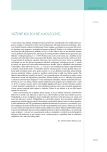-
Medical journals
- Career
Different perspective of overactive bladder from a view of patients and urologists
Authors: Roman Zachoval 1; Jan Krhut 2; Miroslav Záleský 1; Vladimír Borovička 1
Authors‘ workplace: Urologické oddělení Fakultní Thomayerova nemocnice, Praha 1; Urologické oddělení, Fakultní nemocnice Ostrava 2
Published in: Ces Urol 2011; 15(1): 24-34
Category: Original article
Overview
Aim:
Significant increase of interest for overactive bladder (OAB) in the recent years has not been accompanied accordingly by an increase of knowledge among medical professionals and general population. This was a reason for our survey about important aspects of overactive bladder among medical professionals and normal population.Material and methods:
Primary end point of the study was to find out what are points of view of medical professionals and general population on OAB and to compare them. Secondary end point was to find out whether medical professionals utilize the whole spectrum of pharmacological treatment for OAB patients. There were two questionnaires used in this study, one for patients with OAB and the other for their professionals. Questionnaires were distributed in July 2009 among specialists from out patient and in patient departments in Czech Republic (83 urologists and 17 urogynecologists) selected from database of Czech Urological Society and then were statistically evaluated.Results:
Completely filled out questionnaires were obtained from 59 specialists and 329 patients. In a group of patients 77% were females and 23% males and the incidence of OAB increased gradually from fourth to seventh decade of age. Incidence of comorbidities of patients was very high, more than half of patients suffered from cardiovascular conditions and every sixth patient chronic constipation or dementia was present.
Patients fear incontinence the most, even more than cancer, surgical procedure and loss of job in context of OAB. Patients have high expectations for pharmacological treatment of OAB, 95% of them expect more than 50% improvement of symptoms but in only 31% of patients these expectations are fulfilled. The most important side effect of pharmacological treatment of OAB is dry mouth (24% of patients) and need of administration of drugs more than once a day (13% of patients). The majority of patients (90%) have sufficiency of information about OAB but 91% of patients prefer to obtain it from a specialist and not from multimedia.
According to the opinion of specialists the incidence of comorbidities of patients is much smaller than reality. Administration of different antimuscarinics for patients with different comorbidities does not respond to specific pharmacologic characteristics of antimuscarinics.Conclusion:
There are lot of different points of view on many aspects of OAB between medical professionals and general population. Therefore it is very important to acquire more data about this topic and to bring near the different points of view by means of better education and communication.Key words:
overactive bladder, expectations, quality of life.
Sources
1. Irwin DE, Milsom I, Hunskaar S, et al. Popualation-based survey of urinary incontinence,
overactive bladder, and other lower urinary tract symptoms in five countries: results of the
EPIC study. Eur Urol 2006; 50(6): 1306–1314.
2. Steward WF, van Rooyen JB, Cundiff GW, et al. Prevalence and burden of overactive bladder
in the United States. World J Urol 2003; 20(6): 327–336.
3. Broďák M, Holub L, Košina J, et al. Prevalence symptomů dolních močových cest a hyperaktivního
močového měchýře u žen a mužů v běžné populaci. Urol pro Praxi 2008; 9(1): 16–20.
4. Kučera Z. Inkontinence u muže a ženy v různých fázích životního cyklu ve světle populačního
výzkumu. www.inco-forum.cz
5. Renganathan A, Robinson D, Cardozo L, et al. Do women with overactive bladder have
realistic expectations for therapy? Int Urogynecol J 2010; 21(4): 409–414.
6. Artibani W. Outcomes in overactive bladder treatment: patient perception – a key to success.
Eur Urol 2007; Suppl 6 : 17–22.
7. Athanasopoulos A, Mitropoulos D, Giannitsas K, Perimenis P. Safety of anticholinergics in
patients with benign prostatic hyperplasia. Expert Opin Drug Saf 2008; 7(4): 473–479.
8. Patel B, Bavendam T, Badlani G. Use of antimuscarinics in the elderly. Scientific World Journal
2009; 9 : 459–465.
9. Basra RK, Wagg A, Chapple C, et al. A review of adherence to drug therapy in patients with
overactive bladder. BJU Int 2008; 102(7): 774–779.
Labels
Paediatric urologist Nephrology Urology
Article was published inCzech Urology

2011 Issue 1
Most read in this issue- Evidence based medicine
- Role of a glansectomy in treatment of penile cancer
- Urological complications of pelvic fractures
- Different perspective of overactive bladder from a view of patients and urologists
Login#ADS_BOTTOM_SCRIPTS#Forgotten passwordEnter the email address that you registered with. We will send you instructions on how to set a new password.
- Career

